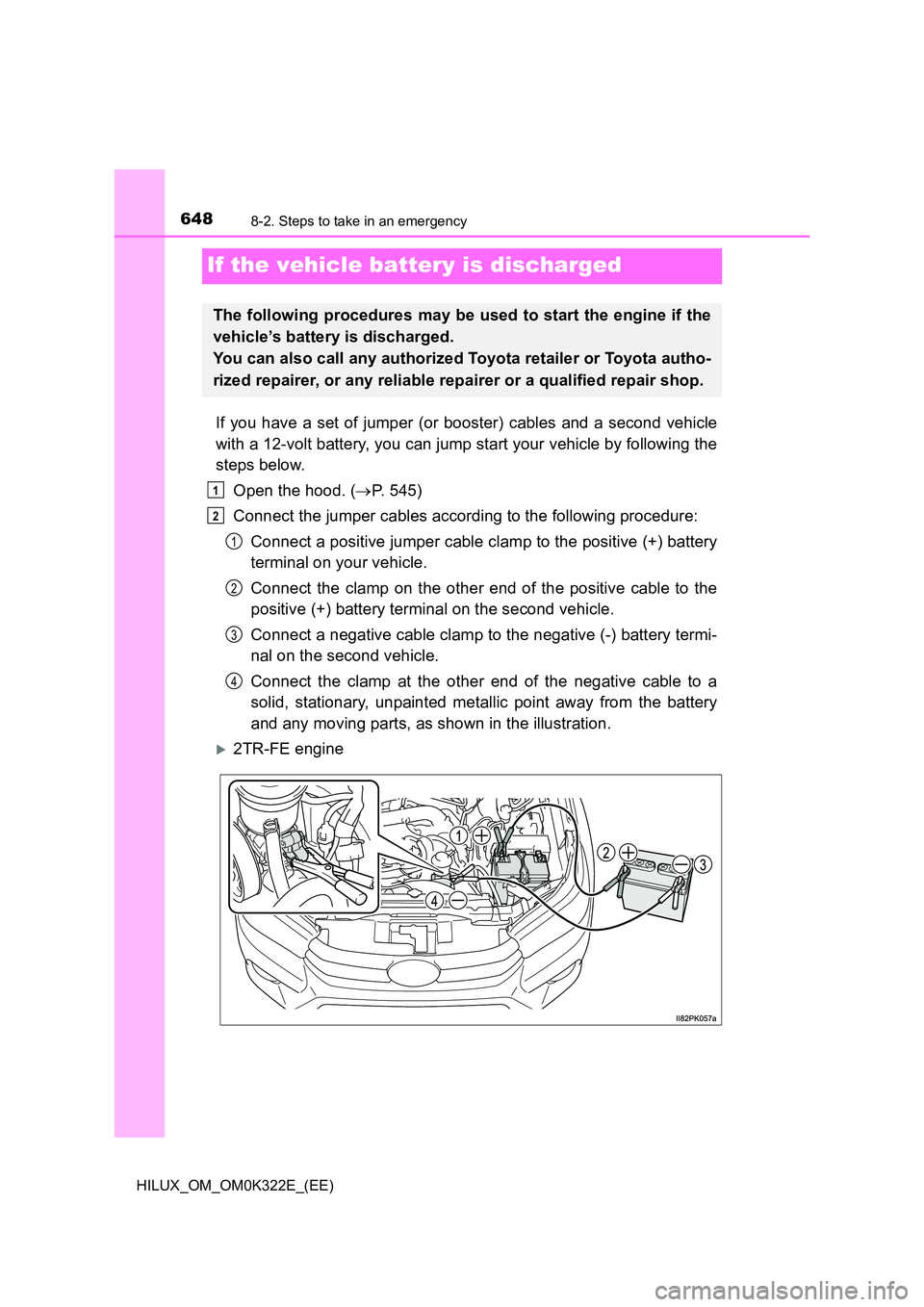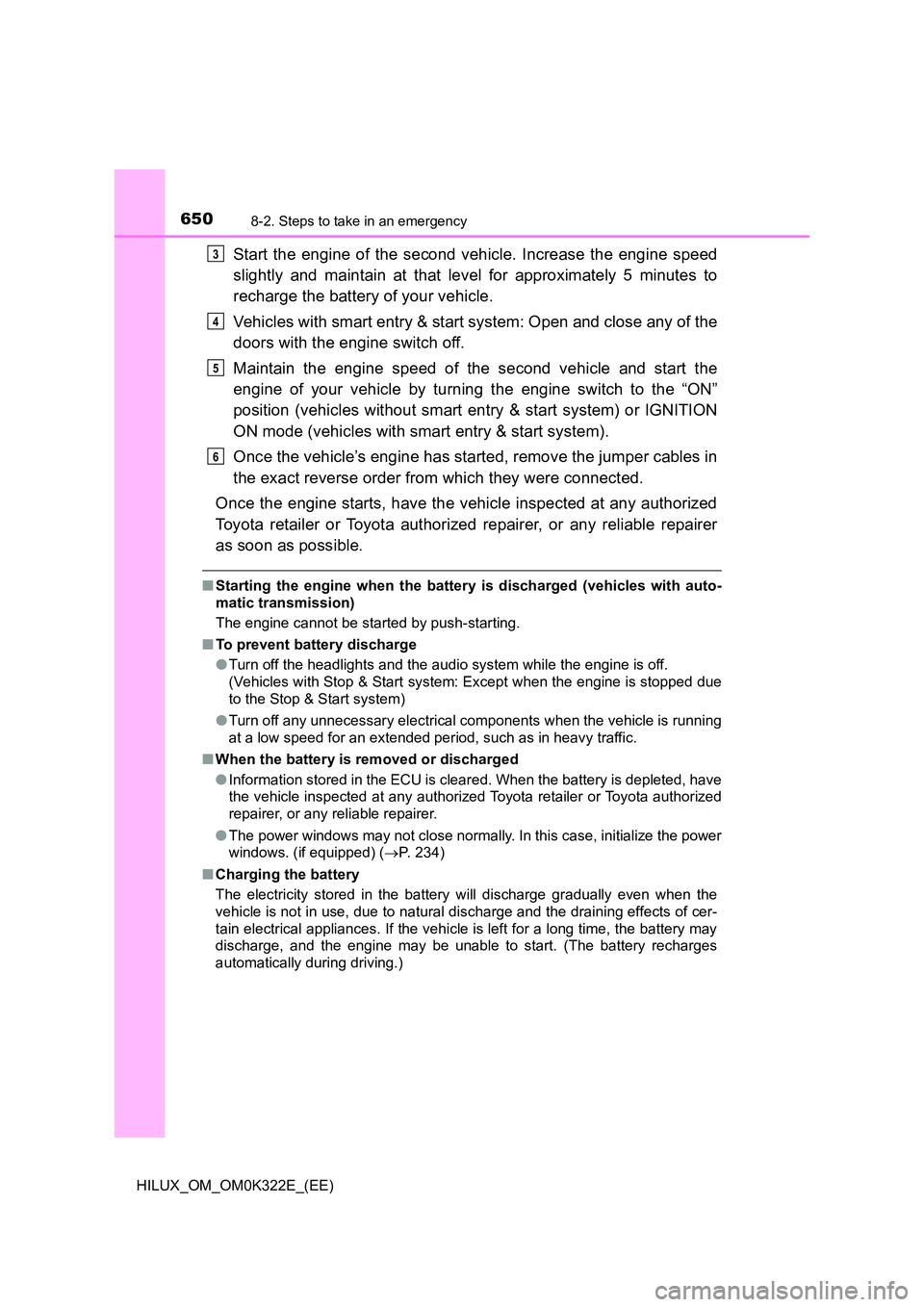Page 648 of 720

6488-2. Steps to take in an emergency
HILUX_OM_OM0K322E_(EE)
If the vehicle battery is discharged
If you have a set of jumper (or booster) cables and a second vehicle
with a 12-volt battery, you can jump start your vehicle by following the
steps below.
Open the hood. ( P. 545)
Connect the jumper cables according to the following procedure:
Connect a positive jumper cable clamp to the positive (+) battery
terminal on your vehicle.
Connect the clamp on the other end of the positive cable to the
positive (+) battery terminal on the second vehicle.
Connect a negative cable clamp to the negative (-) battery termi-
nal on the second vehicle.
Connect the clamp at the other end of the negative cable to a
solid, stationary, unpainted metallic point away from the battery
and any moving parts, as shown in the illustration.
2TR-FE engine
The following procedures may be used to start the engine if the
vehicle’s battery is discharged.
You can also call any authorized Toyota retailer or Toyota autho-
rized repairer, or any reliable repairer or a qualified repair shop.
1
2
1
2
3
4
Page 650 of 720

6508-2. Steps to take in an emergency
HILUX_OM_OM0K322E_(EE)
Start the engine of the second vehicle. Increase the engine speed
slightly and maintain at that level for approximately 5 minutes to
recharge the battery of your vehicle.
Vehicles with smart entry & start system: Open and close any of the
doors with the engine switch off.
Maintain the engine speed of the second vehicle and start the
engine of your vehicle by turning the engine switch to the “ON”
position (vehicles without smart entry & start system) or IGNITION
ON mode (vehicles with smart entry & start system).
Once the vehicle’s engine has started, remove the jumper cables in
the exact reverse order from which they were connected.
Once the engine starts, have the vehicle inspected at any authorized
Toyota retailer or Toyota authorized repairer, or any reliable repairer
as soon as possible.
■ Starting the engine when the battery is discharged (vehicles with auto-
matic transmission)
The engine cannot be started by push-starting.
■ To prevent battery discharge
● Turn off the headlights and the audio system while the engine is off.
(Vehicles with Stop & Start system: Except when the engine is stopped due
to the Stop & Start system)
● Turn off any unnecessary electrical components when the vehicle is running
at a low speed for an extended period, such as in heavy traffic.
■ When the battery is removed or discharged
● Information stored in the ECU is cleared. When the battery is depleted, have
the vehicle inspected at any authorized Toyota retailer or Toyota authorized
repairer, or any reliable repairer.
● The power windows may not close normally. In this case, initialize the power
windows. (if equipped) ( P. 234)
■ Charging the battery
The electricity stored in the battery will discharge gradually even when the
vehicle is not in use, due to natural discharge and the draining effects of cer-
tain electrical appliances. If the vehicle is left for a long time, the battery may
discharge, and the engine may be unable to start. (The battery recharges
automatically during driving.)
3
4
5
6
Page 653 of 720
6538-2. Steps to take in an emergency
HILUX_OM_OM0K322E_(EE)
8
When trouble arises
WARNING
■When exchanging the battery
● When the vent plug and indicator are close to the hold down bracket, the
battery fluid (sulfuric acid) may leak.
● For information regarding battery replacement, contact any authorized
Toyota retailer or Toyota authorized repairer, or any reliable repairer.
■ To prevent damage to the vehicle (vehicles with manual transmission)
Do not pull- or push-start the vehicle as the three-way catalytic converter or
catalytic converter may overheat and become a fire hazard.
NOTICE
■ When handling jumper cables
When connecting the jumper cables, ensure that they do not become entan-
gled in the cooling fan or belt.